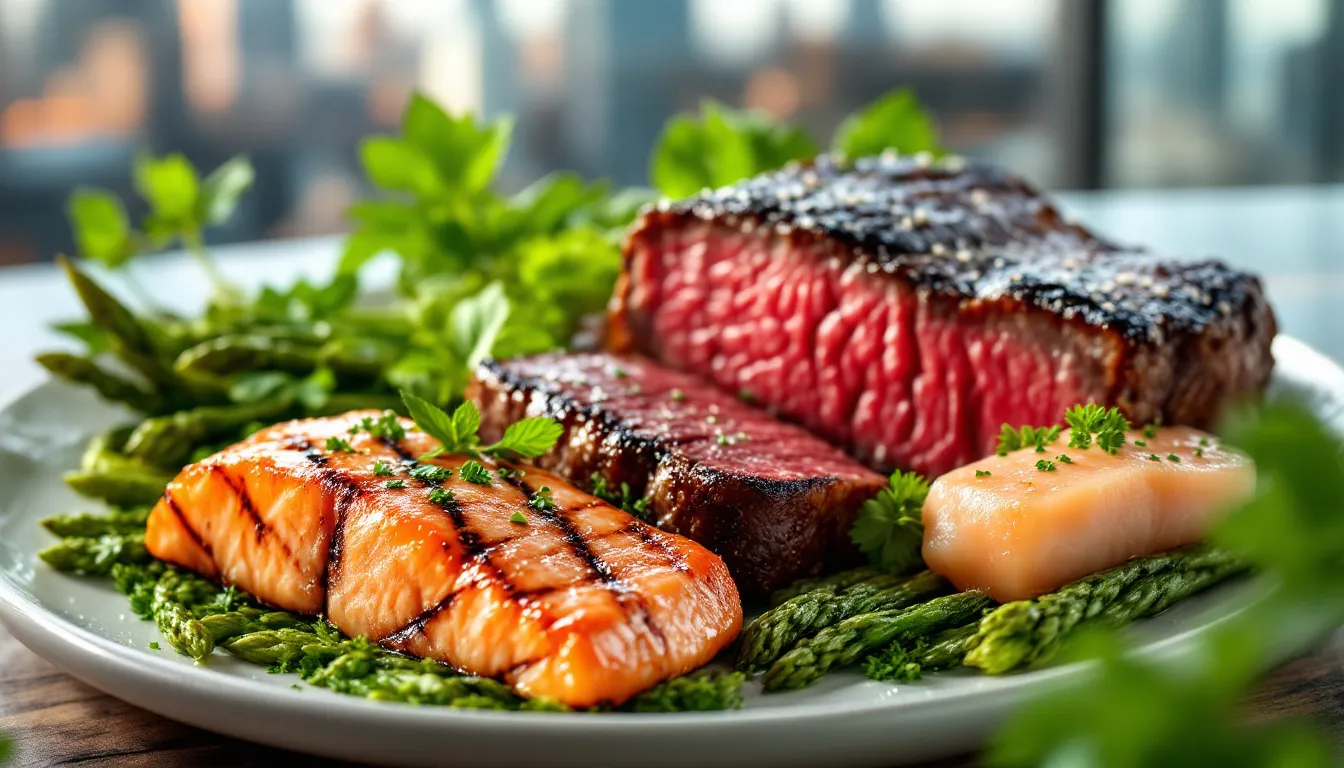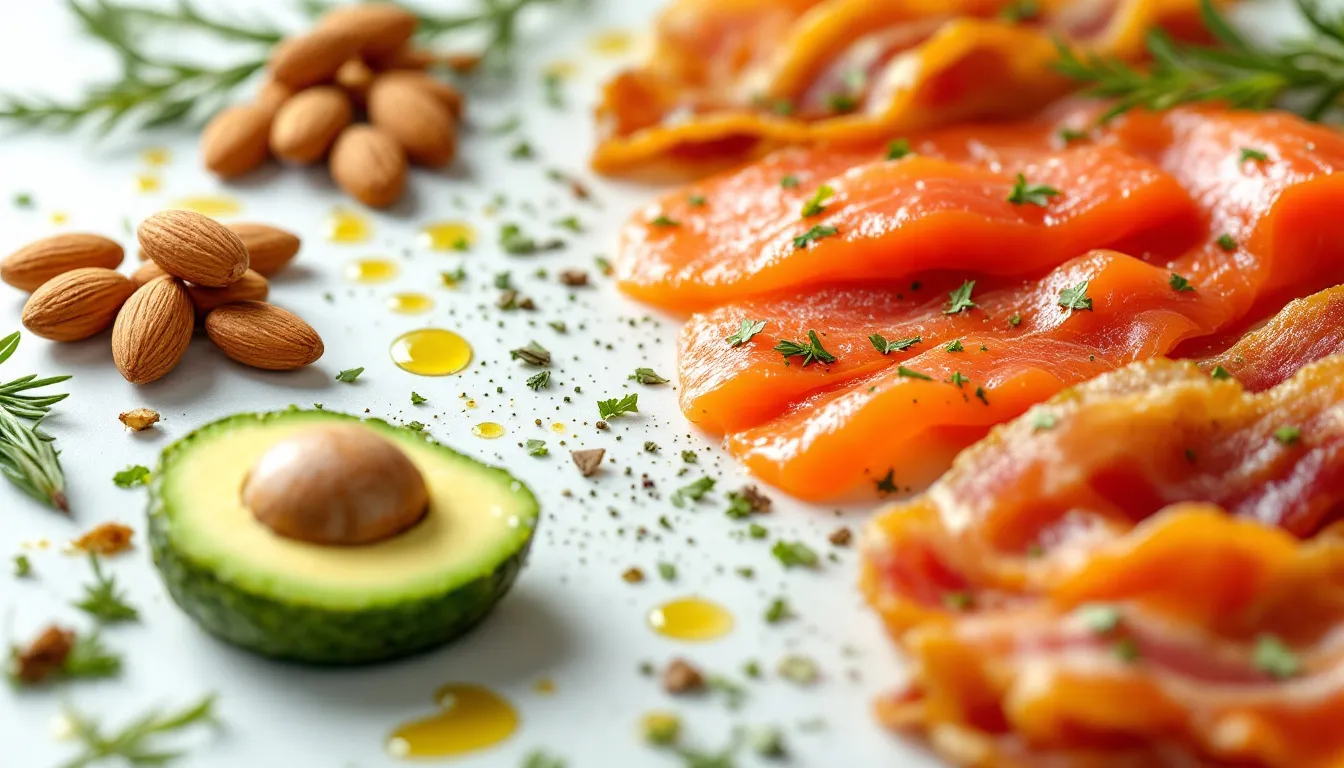Top 10 Foods to Eat if You Want to Get Shredded

Want to get shredded? Your diet is crucial. In this guide, we’ll detail what to eat to get shredded, focusing on the top foods for burning fat and building muscle so you can achieve a lean, sculpted body.
What to Eat to Get Shredded: Key Takeaways
-
Prioritize a balanced diet of high-quality proteins, essential carbohydrates, healthy fats, and fiber-rich foods to optimize fat loss and muscle gain.
-
Calculate and manage calorie intake by maintaining a calorie deficit and tracking macronutrient ratios to achieve your fitness goals effectively.
-
Incorporate meal timing strategies and hydration to enhance metabolism and recovery, ensuring you stay consistent in your path to getting shredded.
Understanding Nutrition for Getting Shredded

Nutrition plays a pivotal role in getting shredded. A balanced diet is crucial for building muscle and promoting fat loss. It’s not just about cutting calories; it’s about consuming the right nutrients that fuel your body and support your goals. Proper nutrition combined with hard work in the gym is necessary for optimal results.
Managing your macronutrients—proteins, carbohydrates, and fats—is essential for optimizing metabolism and supporting fat reduction. A high-protein, low-carb, moderate-fat diet is often suggested for getting shredded. This approach ensures you lose fat without sacrificing lean muscle mass, which is vital for achieving a lean, sculpted appearance.
The key to a successful weight loss and muscle gain plan lies in focusing on three pillars of physical transformation: nutrition, training, and supplementation. By incorporating high-quality protein, essential carbohydrates, healthy fats, and fiber-rich foods into your diet, you can build muscle and get abs while promoting fat loss. A realistic and sustainable nutrition plan is crucial for long-term success.
Calculate Calorie Needs
One of the first steps in getting shredded is calculating your calorie needs. Maintaining a calorie deficit—consuming fewer calories than your body burns—is necessary for fat loss. Using a free macronutrient calculator can help determine your optimal calorie and macro intake. This tool will guide you in adjusting your carbohydrate, protein, and fat intake to achieve your goals.
Tracking your calorie and macronutrient intake regularly is important. This practice helps identify dietary adjustments needed for continued weight loss. Reducing daily calories and focusing on nutrient-dense foods helps create a sustainable meal plan that supports fat loss.
Macronutrient Breakdown
Knowing the roles of macronutrients in your diet fine-tunes your nutrition plan. A balanced intake of 40-50% carbohydrates, 25-35% protein, and 20-30% fat is often recommended for effective weight loss. This distribution ensures that you have enough energy for workouts, sufficient protein for muscle repair, and healthy fats for hormone regulation.
Distributing your protein intake evenly throughout the day, especially focusing on lean protein sources, can enhance muscle protein synthesis. This approach helps preserve lean muscle mass while you drop body fat. Paying attention to macronutrient ratios helps optimize body composition and achieve a shredded physique.
High-Quality Protein Sources
Protein is essential for muscle building and fat loss during a transformation plan. High-quality protein sources are vital for muscle repair and growth. Including a variety of protein-rich foods in your diet ensures you receive all necessary amino acids for your goals. Incorporating a protein shake into daily meals can maximize protein intake, as they are easier to absorb compared to solid proteins and are especially beneficial around workouts for optimal benefits.
Let’s explore some of the best protein sources for getting shredded.
Chicken Breast
Chicken breast is a bodybuilding staple due to its high protein content and low calorie count. With about 24 grams of protein per 3 ounces, chicken breast is a prime choice for muscle building. Chicken breast can help overcome weight loss plateaus by raising metabolic rate and enhancing satiety.
Eggs
Eggs are almost pure protein, making them an ideal food choice for those trying to get shredded. Each large egg provides roughly 6 grams of protein, which supports muscle maintenance and promotes feelings of fullness.
Eggs are particularly high in leucine, an amino acid that plays a critical role in muscle protein synthesis.
Greek Yogurt
Greek yogurt is a high-protein food that offers 23 grams of protein per 8 ounces. It contains both fast- and slow-digesting proteins, making it ideal for muscle recovery.
Greek yogurt supports muscle growth and repair after intense workouts.
Essential Carbohydrates
Carbohydrates are the primary energy source for muscle activity and are crucial for optimal physical performance. They provide the fuel needed for intense workouts and help sustain energy levels. Carbohydrates should be carefully managed to support fat loss and prevent muscle breakdown.
Let’s look at some essential carbohydrate sources.
Brown Rice
Brown rice is a healthy carbohydrate source that provides sustained energy, making it ideal for maintaining performance during workouts. Complex carbohydrates like brown rice support energy levels and recovery during workouts.
Sweet Potatoes
Sweet potatoes are rich in vitamins and provide a sustained energy release, making them an excellent carbohydrate choice for muscle support. Slow-digesting carbs help reduce the impact of insulin. This effect lowers hunger and fat storage.
Healthy Fats for Fat Loss

Healthy fats are crucial for energy, nutrient absorption, and hormone production, all of which support weight loss. They play an essential role in hormone regulation and reducing inflammation in the body.
Let’s explore some healthy fat sources that can aid in your fat loss journey.
Avocados
Avocados are rich in healthy fats, particularly monounsaturated fats, which promote heart health. The combination of fiber and monounsaturated fats in avocados enhances satiety and aids in weight management.
Avocados can improve feelings of fullness and support weight loss.
Olive Oil
Olive oil is a key source of monounsaturated fats linked to reduced inflammation and support for fat loss. Consuming olive oil not only promotes fat loss but also helps in reducing inflammation in the body.
Olive oil supports overall health and fat loss efforts.
Nuts
Nuts are nutrient-dense and provide weight loss benefits, decent satiety, and contain omega-3 fatty acids and ALA. They have a good satiety index due to their macronutrient composition and high fiber content, making them beneficial for weight management.
Fiber-Rich Foods
Fiber-rich foods are essential for appetite control, digestion, and overall health. Certain types of soluble fiber can help reduce appetite by forming a gel-like substance in the gut, leading to prolonged fullness.
Fiber-rich foods support fat loss efforts and improve digestion.
Vegetables
Vegetables help control hunger and improve digestion in a shredded diet. Vegetables like Brussels sprouts and asparagus are excellent sources of viscous fibers that aid weight loss.
Beans
High in fiber and protein, beans support muscle gain and are beneficial during a cut. Legumes like beans and lentils are particularly beneficial for those aiming to preserve muscle while losing fat.
Hydration and Its Role in Getting Shredded
Staying hydrated can increase the thermogenic effect of food, leading to burning more calories during digestion. Prioritizing water, coffee, tea, or protein shakes helps with hydration and supports fat loss efforts.
Hydration plays a crucial role in getting shredded.
Water Intake
A general guideline is to drink half your body weight in ounces of water daily. Proper hydration is crucial for overall health and optimal physical performance. Consuming enough water can help manage calorie intake as it contains zero calories and supports various metabolic processes.
Green Tea
Green tea can enhance fat metabolism and is often favored for its antioxidant properties. It can aid in fat burning and metabolism, making it a beneficial beverage choice for those aiming to get shredded.
Supplements for Enhanced Results
Dietary supplements can provide an edge for individuals seeking to get shredded by helping to maintain consistency in results. Supplements like whey protein, creatine, BCAAs and pre workout can significantly support muscle growth and recovery.
Let’s delve into some key supplements that can enhance your fat loss and muscle gain efforts.
Whey Protein
Whey protein is known for its rapid digestion, making it a popular choice for post-workout recovery. Fast digesting whey protein shakes before and after workouts boost muscle repair and growth. Protein powder can also be a convenient option for those looking to enhance their protein intake.
Whey protein provides a high-quality source of protein, essential for muscle retention and overall fat loss efforts.
Branched Chain Amino Acids (BCAAs)
BCAAs are essential for preserving muscle tissue during intense workouts and are crucial for muscle retention. Consuming 5 to 10 grams of BCAAs can help prevent muscle protein breakdown and support muscle preservation.
BCAAs help maintain lean muscle while losing fat.
Omega-3 Fatty Acids
Omega-3 fatty acids improve health markers, promote fat loss, support muscle growth, and enhance insulin sensitivity. They also enhance nutrient partitioning, driving nutrients into muscle cells and increasing muscle efficiency.
Omega-3 fatty acids benefit overall health and fat loss efforts, especially when sourced from fatty fish.
Meal Timing and Frequency
Meal timing and frequency are crucial for maintaining metabolism and muscle mass during a cutting phase. Eating small meals every 2.5-3 hours helps sustain metabolism and preserve muscle while promoting fat loss.
Strategies for optimizing meal timing and frequency are important.
Frequent Small Meals
Eating every 2.5-3 hours is recommended for optimizing fat loss and maintaining muscle mass. Frequent meals help maintain an anabolic state, promoting muscle building and preventing muscle breakdown.
Planning meals in advance and using apps to track nutrient intake support fat loss efforts.
Post-Workout Nutrition
The post-workout anabolic window lasts about 30-60 minutes when muscles are most receptive to nutrients. Including fast-digesting carbohydrates post-workout supports quick energy replenishment and helps in recovery.
High-quality protein consumption after workouts boosts recovery and muscle growth.
Avoiding Common Pitfalls
During a cutting phase, individuals often face increased hunger and possible decreased metabolism. Avoiding common pitfalls such as consuming too many calories and skipping meals is crucial for maintaining progress.
Let’s discuss how to navigate these challenges effectively.
Too Many Calories
A calorie deficit is crucial for fat loss. Consuming fewer calories than the body expends helps in retaining muscle mass while dropping body fat.
Meal prepping, monitoring portion sizes, and avoiding high-calorie processed foods help manage calorie intake.
Skipping Meals
Skipping meals can lead to unhealthy snacking and overeating later, compromising diet goals. It can also cause fluctuations in energy levels, impacting workout performance.
Maintaining consistent meal patterns and eating frequent small meals can support metabolism and fat loss efforts.
Fine-Tuning Your Nutrition Plan
Adjustments in diet can significantly enhance muscle gain and fat loss results. Tracking progress and making necessary adjustments to your meal plan can help overcome plateaus and sustain progress.
Strategies for fine-tuning your nutrition plan are essential.
Monitoring Progress
Tracking weight, body composition, and energy levels regularly assesses the effectiveness of a nutrition plan. Taking daily weight measurements and weekly body measurements at multiple points can provide a clearer picture of body composition changes.
Understanding your Total Daily Energy Expenditure (TDEE) helps establish a baseline for caloric intake for weight loss.
Adapting to Plateaus
Modifying macronutrient ratios helps break through weight loss plateaus. Regularly monitoring progress and making necessary adjustments to the nutrition plan are vital for continued success. Gradually adjusting macronutrient ratios can help maintain progress and overcome plateaus.
Summary
In conclusion, achieving a shredded physique requires a comprehensive approach to nutrition. From calculating calorie needs and understanding macronutrient breakdowns to incorporating high-quality protein, essential carbohydrates, healthy fats, and fiber-rich foods, every aspect of your diet plays a crucial role. Staying hydrated, using supplements, optimizing meal timing, and avoiding common pitfalls are all part of the journey. Remember, consistency and dedication to your nutrition plan will help you get shredded and maintain your results.
Frequently Asked Questions
How important is protein in getting shredded?
Protein is crucial for getting shredded as it supports muscle building and fat loss. Incorporating high-quality protein sources will help you repair and grow muscle, leading you to your lean physique goals!
What are some good sources of healthy fats?
Incorporating avocados, olive oil, nuts, and fatty fish into your diet provides essential healthy fats that can boost your overall well-being. Embrace these foods for better hormone balance and reduced inflammation!
How often should I eat to optimize fat loss?
To optimize fat loss, aim to eat small meals every 2.5-3 hours; this keeps your metabolism active and supports muscle retention, empowering you on your journey to a healthier you!
What role does hydration play in getting shredded?
Hydration plays a vital role in getting shredded by boosting the thermogenic effect of food, which helps you burn more calories during digestion. Keep those water levels up to maximize your results and enhance your performance!
How can I avoid common pitfalls during a cutting phase?
To avoid common pitfalls during a cutting phase, focus on meal prepping and monitoring portion sizes to stay on track. Consistency is key, so keep your meals regular to effectively manage calorie intake and achieve your fat loss goals!





































